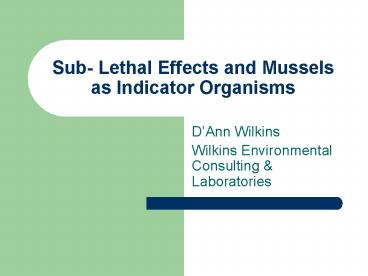Sub Lethal Effects and Mussels as Indicator Organisms - PowerPoint PPT Presentation
1 / 13
Title:
Sub Lethal Effects and Mussels as Indicator Organisms
Description:
What about mussels? Also used as indicator organism. ... Not consistent to represent health of in-stream mussel community. ( bioassessments) ... – PowerPoint PPT presentation
Number of Views:34
Avg rating:3.0/5.0
Title: Sub Lethal Effects and Mussels as Indicator Organisms
1
Sub- Lethal Effects and Mussels as Indicator
Organisms
- DAnn Wilkins
- Wilkins Environmental Consulting Laboratories
2
What is WET?
- A biological endpoint test to determine lethal or
sub-lethal effects. - Lethal- A significant effect in survival compared
to control. - Sublethal- A significant effect in growth and
reproduction compared to control
3
Why do we use indicator organisms?
- To determine the effects of the effluent matrix
as a whole. (vertebrate and invertebrate) - What affects the individual constituents in the
effluent (ie. additive, synergistic etc.) - Constituents such as Cd, Zn, Ni, Pd, Cu
- (toxicity varies ug/L to mg/L) together very
toxic! (invertebrate) - Wastewater treatment products (both species)
- TDS (invertebrate)
- Ammonia (vertebrate)
- You can be meeting numerical limits and still
fail a WET test!
4
What types of tests?
- Acute high flow stream-48 hour
- Chronic low flow stream -7 day
- Acute and chronic in between
- 21 Day life cycle Daphnia magna
5
What type of organisms?
- Invertebrates
- Daphnia pulex 48 hour acute
- Daphnia Magna 48 hour acute, 21 day
- Ceriodaphnia dubia 7 day chronic
- Vertebrates
- Pimephales promelas 48 hour acute, 7day
6
Lethal and Sublethal Effects
- What does that mean from a compliance
perspective? - Lethal effects covered by TRE trigger
- Retesting required
- Sublethal recognized only as a case by case
basis. - No retesting requirement in permit
- PMSD is key
7
What is PMSD
- Percent Minimum Significant Difference
- Measures the intra-variability within a WET test.
- Laboratories must adhere to acceptability
criteria for test to be valid. - Further analysis of statistics required to
determine true sublethal effect.
8
Sublethal
- Can truly be like looking for a needle in a hay
stack! - Type of toxicant determines toxic signal
- Biologically active-not persistent (organic)
- Not biologically active-persistent (inorganic)
- Toxic signal varies by concentration.
- Need strong signal to determine toxicant.
- Treatability or source control.
9
TRE vs. TIE
- TRE- Toxicity Reduction Evaluation Study
- Sublethal can require TRE, more extensive study
longer period of time. - TIE- Toxicity Identification Evaluation
- Study is specific to toxic sample.
- length of study depends on type of toxicant.
10
What about mussels?
- Also used as indicator organism.
- Not considered part of WET narrative criteria.
- Not consistent to represent health of in-stream
mussel community. (bioassessments) - Good test for presence of chemical constituents.
11
Continued.
- Test relatively new to Oklahoma.
- Not required for any facilities.
- May be considered for more facilities.
- Must be definitive and reliable.
- Open to scrutiny.
12
Indicator Organisms
- An excellent tool if correct test used.
- Representative of effluent quality
- Test results must be reliable.
- Proper test in place LC/50 vs. NOEC
- LC/50 48 hour test to determine lethal effects
only. - NOEC 7 day test to determine lethal and sub
lethal effects.
13
Questions
- DAnn Wilkins
- 832 N.W. 67th St.
- Oklahoma City, OK 73116
- Phone 405-286-0468
- Cell 405-570-9027































